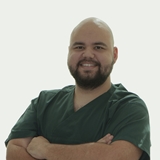Sümer Münneveroğlu

Sümer Münevveroğlu completed his undergraduate degree in dentistry from Istanbul Medipol University in 2016, and then went on to pursue a PhD in maxillofacial surgery at the same institution. He successfully completed his PhD study in 2021 and was subsequently appointed as an assistant professor in the department of oral and maxillofacial surgery at Istanbul Medipol University. His research interests include facial trauma, orthognathic surgery and dental implants.
Determining and Transferring the Natural Head Position for Virtual Planning
The Natural Head Position (NHP) is critical for successful virtual planning in maxillofacial surgery. Virtual planning offers various benefits, such as increased efficiency, accuracy, and predictability, and helps surgeons visualize the desired outcome before the actual surgery, improving communication with the patient and reducing operative time. Moreover, virtual planning focuses on soft tissue more than conventional planning, making the head position crucial. This presentation discusses various methods for determining and transferring the NHP in virtual planning, along with their clinical implications.
Several methods, such as the use of an inclinometer, the "self-balance" technique with or without a mirror, corrected head position, and looking at the horizon have been developed to determine the NHP. Once the NHP is determined, it should be accurately transferred into the virtual environment. In the literature various methods for accurate transfer, such as stereophotogrammetry, manual orientation according to NHP photographs, self-leveling laser and skin markers, and laser scanners were described.
This presentation highlights the importance of accurate determination and transfer of the Natural Head Position in virtual planning for maxillofacial surgery. It explores the clinical implications and significance of various available methods for determining and transferring NHP into the virtual environment. Overall, NHP determination and transfer are essential for successful surgical outcomes and improved patient satisfaction.
